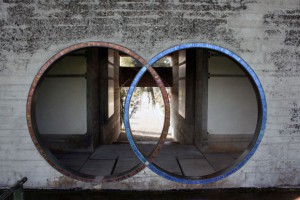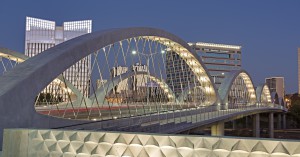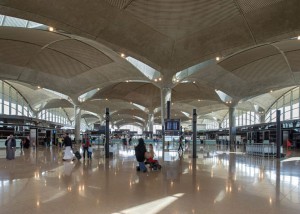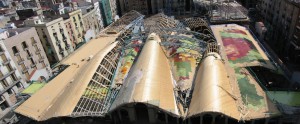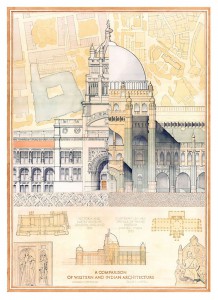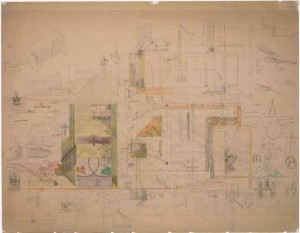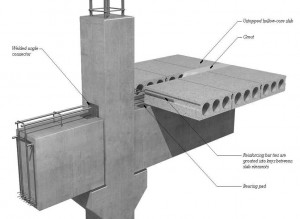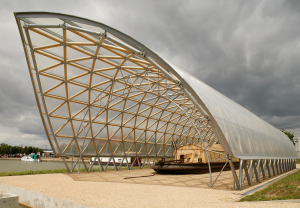The tell-the-tale detail
|
‘……That is to say the “construction” and the “construing” of architecture are both in the detail. Elusive in a traidtional dimensional definition, the architectural detail canbe defined as the union of construction, the result of the logos of techne, with construing, the result of the techne of logos……..Details are much more than subordinate elements: they can be regarded as the minimal units of signification in the architectural production of meanings…….The joint, that is the detail, is the place of the meeting of the mental construing and the of the actual construction.’ WHY After the universal triumph of Robert Venturi’s decorated shed, a lot of building as if the prevalent syndrome are packaged like a giant commodity. Architecture is reducing to scenography or even iconography. Neon signs filled the road in the mid-air as if they were extensions of buildings; malls are always wrapped like gift boxes with pretty facade enclosure. None of those are establishing dialogue between the buildings and people. Building are no longer ontological. Meanwhile, prefabrication has been one of the hottest topics in construction process, especially when more and more attention is driven to construction pollution, site management. This thesis aims to question once again the role of joint, to push the prefabrication of a building to extreme through the revision of the joints, in function, to shorten the construction time to minimal, to ensure site construction give minimal interference to the surrounding and to give flexibility to further alternation; in tectonic, to review the potential dialogue of prefabricated unit, to seek expression in such a change of way of making. In term of precedence, the notion of joint being the delineation to full size or a large scale of any portion of an architectural design can be summed up by the maxim of Mies van der Rohe ‘God Lies in the detail’. Although in works of minimalist like Mies, joint is the technique for minimizing the gap of the two materials, to achieve purity, details are definitely the core of the design such that the joinery parts are minimized while the pure geometry of the architecture can be enhanced. Alternatively, Joint has been used as the signifier, one can look at the work of Carlo Scarpa, the making of joints is almost obsessive, allow an empirical interpretation of the role of detail, making dialogue between the whole and the parts, the relationship between craftsmanship and draftmanship, testing in the processes of perception and production. From a more contemporary perspective, Norman Foster’s works definitely demonstrate the role of joint, many parts and components are not so called ‘standardized unit’ in supplier catalogue, yet, they are not so far from standardization as well. Foster involved heavily in the design of details before the production stage. Prefabrication unit nowadays are mostly available as standardized unit in the catalogues of varies supplier. In the fast running construction industry, it is hard for us to test out every potential as Carlo Scarpa who examine his details every night in site. This thesis aims to not only to test how prefabricated unit can be pushed to extreme and facilitate more in construction and alternation but also how it can be made to construe ideas, not only to solve the practical functions, but also the historical cultural function.
WHAT Joint to express for a building cannot root on nothing, for every architecture has its ontological purpose and therefore not stand for ‘absence’ . In Hong Kong, such a city that fumes with ultimate capitalism, it is easy to find giant malls that host numerous unrelated shops and restaurants. Sadly when you look upon the structure and the space that decorated under tones of gypsum boards, you would found the ultimate generic. To test out the dialogue potential of prefabricated unit, it is essential to test on a culture rich case. Market is picked as the test case typology as it is the oldest typology in human history after the private shelter exist, it has always been the convegent point of people and culture. In the past, it is the centre of a society and the core of a region. People do not have strong linkage with any generic commodity just as no one is remember what are their last ten products bought from supermarket. Malls/markets become one of the commodities that require constant changes and renewal. In Hong Kong, most of the first class mall would have their entire renovation works done every two decades, not to mention the seasonal repackage of the interior. Take this as an opportunity for focus, how the prefabricated unit can faciliate any changes if needed and let the arrangement be more flexible is taken as a technical focus of the thesis. Currently, most of the malls are constructed with concrete, in which the structures are bonded together in situ no matter with prefabricated elements or not. That is, structural elements are fusion into one piece. It is very inconvenient from any changes or alternation. Prefabricated structural elements can allow reduction in construction time and reduce the pollutions on site and surrounding. Yet, the biggest advantage that prefabrication might mean to be accuracy. The precision of the unit allow more adaptability and interchangable arrangment between units. The testing typology should also include long span as a character. through the advantage of prefabrication, how to limit of span can be achieved and adjustable will be one of the core issue for the thesis. The ideal typology may be an advanced primitive shelter that in building scale while host the core value of the area. Temporary site of the test case are in MongKok, one of the oldest region in Hong Kong. The Sai Yee Street has been called as ‘sneaker Street’ as it hosts over 100 sportswear shops. It is one of the hot spot that made the area fill with people. The chosen site is currently worked by URA as a redevelopment of the area with a large sports mall. The area are filled with tenament buildings and a football field nearby, it is a chanllege to retrive the identity of the area and transform it into a modern building in ontological expression. Such that the product would not merely be a representational of the past but a self contained vessel which project into the new age.
HOW The research of this thesis demands a consolidated understanding and development on prefabrication unit limitation like material constraints, weight of the units, combination of different prefabricate unit.the geommetry of the unit, dimension etc In the second step, gear to facilitate the composition process, specific geommetry of the details, ways of construction and interchanging will be investigated. After the prototype is developed into a mutural system, it will further be articulated base on the culture idea. Once the illustrative analytique is fixed, prototype with different joinery methods should be tested out as 1:50/1:100 model for the whole building test case. The prototype is to examine the limit of the prefabrated unit and also the composition effect of such detail.
Bibliography Theory and backgorund research: The Case for the Techtonic, Kenneth Frampton, in Architectural Design v.60#3-4 (NewTork : St.Martin’s Press,1990, 19-26 Design, Ecology, Ethics and the Making of Things, William Mcdonough, Theorizing a new agenda for architecture an anthology of architectural theory 1965-1995, Kate nesbitt, Princeton Archtiectural Press Technical Building Method: |
